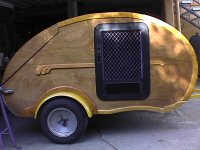I don't know exactly how you are planning to distribute the weight in your trailer in its "ready to hit the road state" but the criteria you reference above (trailer 3000#, 360# tongue weight, 500# behind the axle, and 2500# in front of the axle) seems, intuitively, like it would difficult/impossible achieve. I'd like to see details on your "weight distribution plan" and perhaps some calculations. PPPPPPP. PM me if you don't know what PPPPPPP means.
Cheers,
Gus
Gus,
I posted that without thinking it out so I could clearly explain...my bad.
To be exact...
Using Andrew's weight calculator;
Total weight is 3150 pounds when going down the road.
For now, in the design stage, I'm using 2700 pounds as overall weight.
The trailer is 168" (box)
Trailer with tongue is 208"
Axle/wheel center is 63" from the rear.
If I plug in 3150 pounds as the trailer weight, I get a tongue weight of 514 pounds (16.3%)
That is too much...
After calculating how much weight will be forward, and rear of the axle, I'm using 2700 pounds as the overall weight of the trailer.
By reconfiguring the interior to take a number of heavy items behind the axle, I then added that weight, which is 450 pounds, to reduce the tongue weight to a reasonable 357 pounds (11.3%)
Seemed a good way to me to help "balance" the load, without moving the axle so far forward that it looked odd, or interfered with my doorway.
Since Andrew cautioned against the "Dumb-bell" or see-saw effect, I wanted to try to understand at what point does this "effect" come into play.
As Andrew is much better at math than I, I was hoping he might explain the theory behind the statement, so I could apply it and be a happy camper.

Rob





